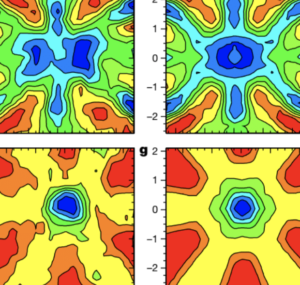Our teams have been busy developing the path towards a Nuclear clock. We are as excited to announce three publications that show some new and groundbreaking insights.
Photon lights a path towards a nuclear clock
A long-sought photon that is emitted by the nucleus of a thorium isotope has now been observed. The feat is a key step in efforts to build a nuclear clock, a device that is precise enough to probe the Universe’s best-kept secrets.
Adriana Pálffy, published in Nature May 24th, 2023
Observation of the radiative decay of the 229Th nuclear clock isomer
The radionuclide thorium-229 features an isomer with an exceptionally low excitation energy that enables direct laser manipulation of nuclear states. It constitutes one of the leading candidates for use in next-generation optical clocks1,2,3. This nuclear clock will be a unique tool for precise tests of fundamental physics4,5,6,7,8,9. Whereas indirect experimental evidence for the existence of such an extraordinary nuclear state is substantially older10, the proof of existence has been delivered only recently by observing the isomer’s electron conversion decay11. The isomer’s excitation energy, nuclear spin and electromagnetic moments, the electron conversion lifetime and a refined energy of the isomer have been measured12,13,14,15,16. In spite of recent progress, the isomer’s radiative decay, a key ingredient for the development of a nuclear clock, remained unobserved. Here, we report the detection of the radiative decay of this low-energy isomer in thorium-229 (229mTh). By performing vacuum-ultraviolet spectroscopy of 229mTh incorporated into large-bandgap CaF2 and MgF2 crystals at the ISOLDE facility at CERN, photons of 8.338(24) eV are measured, in agreement with recent measurements14,15,16 and the uncertainty is decreased by a factor of seven. The half-life of 229mTh embedded in MgF2 is determined to be 670(102) s. The observation of the radiative decay in a large-bandgap crystal has important consequences for the design of a future nuclear clock and the improved uncertainty of the energy eases the search for direct laser excitation of the atomic nucleus.
S. Kraemer, J. Moens, M. Athanasakis-Kaklamanakis, S. Bara, K. Beeks, P. Chhetri, Katerina Chrysalidis, A. Claessens, T.E. Cocolios, J.M. Correia, H. De Witte, R. Ferrer, S. Geldhof, R. Heinke, N. Hosseini, M. Huyse, U. Köster, Y. Kudryavtsev, M. Laatiaoui, R. Lica, G. Magchiels, V. Manea, C. Merckling, L.M.C. Pereira, S. Raeder, T. Schumm, S. Sels, P.G. Thirolf, S.M. Tunhuma, P. Van Den Bergh, P. Van Duppen, A. Vantomme, M. Verlinde, R. Villarreal, and U. Wahl
Published in Nature May 24th, 2023
Excitation and probing of low-energy nuclear states at high-energy storage rings
229Th with a low-lying nuclear isomeric state is an essential candidate for a nuclear clock as well as many other applications. Laser excitation of the isomeric state has been a long-standing goal. With relativistic 229Th ions in storage rings, high-power lasers with wavelengths in the visible range or longer can be used to achieve high excitation rates of 229Th isomers. This can be realized through direct resonant excitation or excitation via an intermediate nuclear or electronic state, facilitated by the tunability of both the laser-beam and ion-bunch parameters. Unique opportunities are offered by highly charged 229Th ions due to the nuclear-state mixing. The significantly reduced isomeric-state lifetime corresponds to a much higher excitation rate for direct resonant excitation. Importantly, we propose electric dipole transitions changing both the electronic and nuclear states that are opened by the nuclear hyperfine mixing. We suggest using them for efficient isomer excitation in Li-like 229Th ions, via stimulated Raman adiabatic passage or single-laser excitation. We also propose schemes for probing the isomers, utilizing nuclear radiative decay or laser spectroscopy on electronic transitions, through which the isomeric-state energy can be determined with an orders-of-magnitude higher precision than the current value. The schemes proposed here for 229Th could also be adapted to low-energy nuclear states in other nuclei, such as 229Pa.
J. Jin, H. Bekker, T. Kirschbaum, Y.A. Litvinov, A. Palffy, A. Petrenko, J. Sommerfeldt, A. Surzhykov, P.G. Thirolf, D. Budker,
Phys. Rev. Research 5, 023134 (2023),



